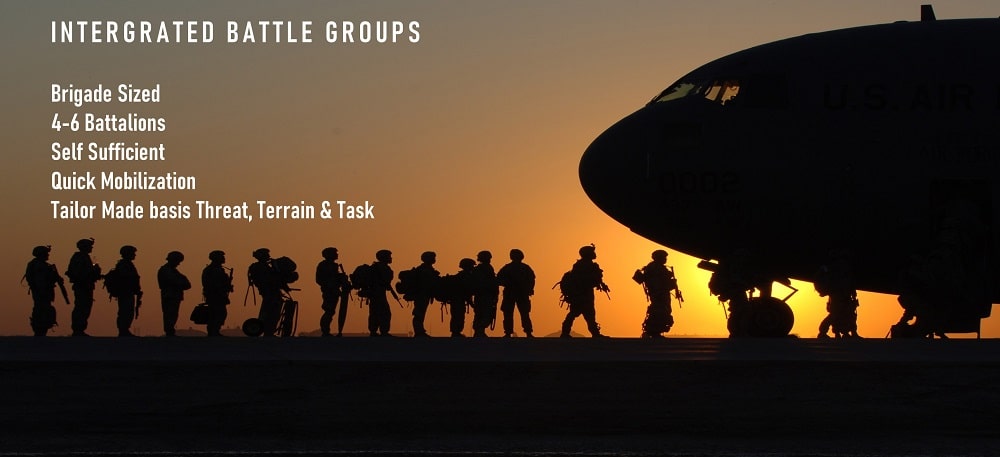What are IBGs?
Integrated Battle Groups or IBGs are brigade-sized, agile, self-sufficient combat formations, which can swiftly launch strikes against an adversary in case of hostilities. The integrated units for the border will be all-encompassing, with artillery, armoured, combat engineers and signal units.
Need for IBGs
It was noted early in the century post terrorist attack on Parliament, that Indian military formations which were deep in hinterland took two weeks for mobilization thus losing the element of surprise
It was further followed by the much debated proactive strike doctrine of ‘Cold Start’ to launch swift offensive. Cold Start called for defensive corps to carry out shallow cross-border thrusts within 72 hours for limited objectives
Integrated Battle Groups were proposed in one of four studies initiated by then Army chief General Bipin Rawat on the overall restructuring of the force. After years of deliberations, the Army decided to raise the IBGs along the borders with China and Pakistan that will help it carry out swift strikes in case of a war.
IBGs are brigade sized agile self-sufficient combat formations which are being created to carry out swift launch strikes. The mobilization time is expected to be around 12-48 hours. The integrated units for the border will be all-encompassing, with artillery, armoured, combat engineers and signal units.
These composite waging units comprising about 20,000 fighting men deployed on vulnerable locations can move with a specific order of battle at short notice
IBGs will help in holistic integration to enhance the operational and functional efficiency, optimize budget expenditure, facilitate force modernization and address aspirations. They will be light and hence low on logistics

Organization
The organization depends on many factors but the main three would be basis Threat, Terrain and Task. Accordingly the type and amount of resources to each battle group would be allocated. An IBG operating in desert will have different constitution than one in operating in mountains
A command constitutes the largest static formation of Army with a defined geography, while a corps is the largest mobile formation. Further each corps has about three brigades. The idea is to reorganize Corps into IBGs which are brigade-sized units but have all the essential elements like infantry, armored, artillery and air defense embedded together
Each IBG is expected to be headed by a Major General ranking officer .The integrated units for the border will be all-encompassing comprising elements of airpower, mechanised, ordnance units, with artillery, armored, combat engineers and signal units. An IBG will also include a signal company, a field company and engineering and ordnance will be merged to form logistics unit
Integrated Battle Groups indicate the structural change to formations with Indian Army moving away from World War-II vintage “Strike Corps” to Short Notice Intense Pre-Escalatory Operations (SNIPEs). As against the traditional fighting formation of corps – each comprising 8-10 brigades, with a brigade having 3-4 battalions – an IBG is likely to have just about 6 battalions
They would perform both defensive and offensive operations. While the offensive IBGs would quickly mobilize and make a thrust into enemy territory for strikes, defensive IBGs would hold ground at vulnerable points
The Mountain Strike Corps are expected to be divided into five to six IBGs. The formations would be terrain specific as the army cannot have a one-size-fits-all approach. The idea is to have smaller and faster force groups.
There are expected to be around four IBGs in Sikkim and another four in Jammu-Sialkot sector. Currently India has four Strike Corps – 1, 2, 21 and 17. The Yol-based 9 Corps will be the first to be re-organised into IBGs and will be deployed along the western border. Further , XXXIII Corps in Siliguri and newly-raised Mountain Strike Corps in Panagarh will have IBGs
Future conflicts are likely to be short and localized, and a strong blow delivered quickly will be crucial to gain or lose territories. The IBGs will have the capacity to raid 10-15 km deep into enemy territory without requiring support. This means tuning to the dynamic modern warfare demands of capturing territories along the border rather than deep penetration. However the Army will maintain strike corps for deep raids if need arises. Not every corps, division or brigade will be replaced by an Integrated Battle Group
Three new tri-services agencies are also being worked upon which are – a Cyber Agency, a Space Agency and an Armed Forces Special Operations Division. These three are to have a joint command. Clearly the focus in on building cyber assets with both, offensive and defensive capabilities
